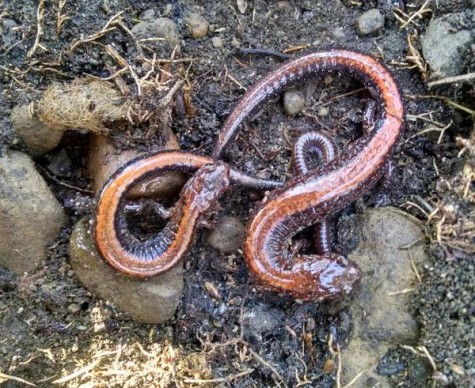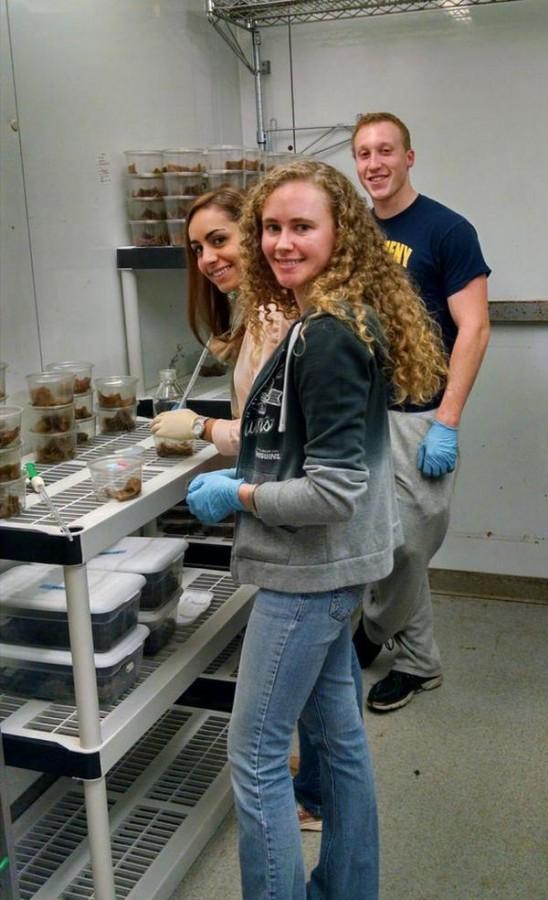Professor Venesky researches deadly pathogen in amphibians
From front to back: Caroline McAllister, ’16, Alexandra Hess, ’16, and Joe DeMarchi, ’16, are three of Venesky’s five students doing research on Bd. Also participating are Julie Marone, ’16, and Makenzie Zidek, ’16.
Matthew Venesky, visiting assistant professor of biology, began research at Allegheny last year on a pathogen that has been attacking amphibians. The pathogen, called Batrachochytrium dendrobatidis, or Bd, affects the levels of keratin in the amphibian’s skin.
When the keratin increase leads to the species developing tougher skin, they are less able to absorb water in their environments, and it leads to heart failure. Some species breathe through their skin, so the increased thickness can also cause suffocation.
The fungus killing off the amphibians is disrupting the balance of the entire ecosystem. Where tadpoles get their nutrients from the algae and turn to frogs, birds then eat the frogs and get the algae’s nutrients. If the tadpoles are dying off, the birds are not getting their nutrients either, which leads to the predators of birds also lacking in their nutrients.
The disruption of the amphibians can lead to an increase in algal blooms in the aquatic ecosystems because the amphibians are not around to keep them under control.
The disease, called chytridiomycosis, was found in the early 1990s, but Venesky supposed that it was around longer.
“I would say that… it was probably spreading around South Africa and the Panama in the 80s,” he said.
With the exception of Antarctica, where there are no amphibians, every continent is suffering from the Bd pathogen. One theory about the pathogen that scientists have is that it has always been around and that a recent stressor on amphibians’ immune systems has allowed them to become infected. Another theory is that the disease has spread from South Africa, since the amphibians there have been showing a resistance to it. This finding has made the second theory more common.
Venesky began working with this disease after doing research with infections in salamanders. Salamanders often live through and clear infections from their systems while other species die within two months. Scientific literature suggests that colors show different abilities of resistance to pathogens in birds and mammals. However, the research had not yet been done on amphibians.
Some salamanders showed a red stripe on their back while others were solidly colored, so Venesky and some of his students researched the effect of Bd on both colored and solid salamanders. Though they expected the solid salamanders to be more resistant, they found the opposite.

Venesky and his students found that the salamanders with a red stripe down the back were more resistent to pathogens than those solidly colored black.
“Compared to the red-striped salamanders, significantly more of the all black salamanders died when infected and their prevalence of infection was higher,” Venesky explained.
This finding led to research on the sublethal effects of the infection on the salamanders. Although they can survive and clear the disease, the process can provoke other harmful results in the salamanders, and Venesky will begin research on what those effects are.
Julie Marone, ’16, has been doing similar research with Venesky for two years.
“I looked at host resistance and stress physiology,” Marone said. Her study evaluated species’ susceptibility to disease based on how stressful their environment was.
Venesky has incorporated his research on the disease into research with his students. Joe DeMarchi, ’16, has also been working with Venesky for two years and he and Marone are currently evaluating with the rest of their group the effect Bd has on the feeding habits of amphibians.
“We’re hoping that their Bd infection affects feeding habits negatively,” DeMarchi said.
Venesky’s research with his students will continue into the Spring semester, and both DeMarchi and Marone will likely be doing their senior compositions on the pathogen with Venesky.









